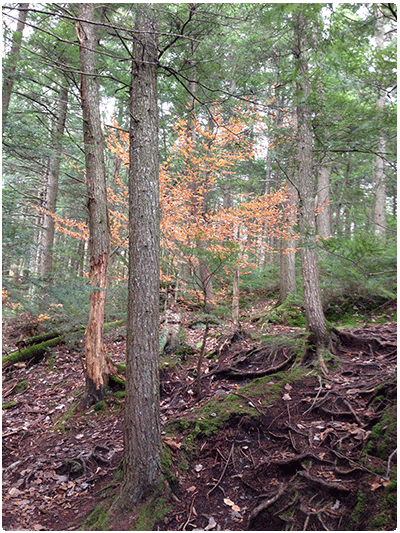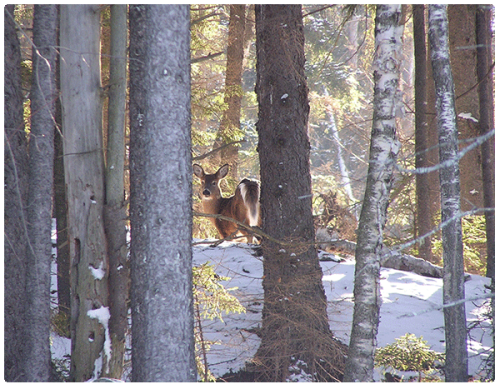Ecology and Physical Setting
This is an important community in the Northern Hardwood Forest Formation, although it occupies a small percentage of the landscape. Prior to European settlement, hemlock comprised about ten percent of the Vermont forest, but today it probably covers less than five percent. Hemlock was used widely for tanning leather in the 18th and 19th centuries, which is one of the factors leading to its decline in the state. It is a shade tolerant, long-lived species, capable of living up to 1,000 years. It is therefore a late-successional species, persisting under the shade of a hardwood canopy for decades, eventually becoming dominant.
Hemlock Forests are more or less pure stands of hemlock, usually covering small areas in a variety of settings. These include steep-sided ravines, slopes, summits, terraces, and cool depressions. Depth to bedrock is variable. Soils are derived from a variety of parent materials, including till, outwash, bedrock, and lake-deposited sediments. A shallow impeding layer, or hardpan, is present in some places. Some soils are seasonally wet. Others tend to be droughty. As is true with other conifers, the needles of hemlock acidify the soils on which they grow, causing minerals to be leached from the upper soil layers. A strong albic horizon, or ashy white layer, can result. In the Northeast, the best expression of an albic horizon is often under an old stand of hemlock.
Hemlock Forests generally occur below 1,800 feet elevation, but the elevation varies from north to south. Hemlock is much less common in the colder areas of the state, including the Northeastern Highlands.
Natural ecological processes include fire, which is especially common on ridgetops that attract lightning, and windthrow, which affects these shallow-rooted trees.
Vegetation
The closed canopy of hemlocks makes these forests very dark. Few flowering plants grow in this deep shade. Scattered marginal wood fern and mounds of pincushion moss dot the forest floor. Hemlock occupies 75 percent to 100 percent of the canopy in Hemlock Forests, with beech, yellow birch, sugar maple, red spruce, and white pine mixed in.
Wildlife Habitat
Hemlock Forests typically occur as patches surrounded by Northern Hardwood Forest. Several species of birds make use of these evergreen forest patches for nesting, including northern saw-whet owl, red-breasted nuthatch, Blackburnian warbler, and black-throated green warbler. The dense evergreen canopy of Hemlock Forests traps snow and provides important winter shelter for white-tailed deer. Porcupines are common, as the inner cambium, buds, and needles of hemlock are preferred winter food.
Successional Trends
 Eastern hemlock is a late-successional species. Hemlock Forests are considered to be stable over long periods of time, and many forests that are dominated by other species today will likely become hemlock- dominated over time.
Eastern hemlock is a late-successional species. Hemlock Forests are considered to be stable over long periods of time, and many forests that are dominated by other species today will likely become hemlock- dominated over time.
Hemlock seeds are small and short-lived, so only a small percentage will germinate. Specific conditions are required for germination: a warm, moist site, either on mineral soil or on a mossy log. Fallen logs and tree root tip ups caused by natural disturbance are ideal. Mossy “nurse” logs can be covered with hemlock seedlings. Once established, these seedlings and saplings can persist for a long time—even decades—growing very slowly under a closed forest canopy. In fact, hemlock is our most shade-tolerant tree species. When a canopy gap is created by disturbance, hemlock grows quickly in the newly available sunlight and fills the gap.
Early-successional species in hemlock forests include red maple, paper birch, aspen, and white pine. Mid-successional species include hemlock, yellow birch, red spruce, and red maple.
Variants
- Hemlock-Red Spruce Forest: Red spruce is common or co-dominant in the canopy. White pine, balsam fir and beech may be present as well. It tends to occur at higher elevations than typical Hemlock Forests.
Related Communities
- Hemlock-Northern Hardwood Forest is similar but has a canopy composition of less than 75 percent hemlock.
- Dry Transition Hemlock Forest is a hemlock-dominated forest of Vermont’s warmer climate areas. This community is distinguished by a scattering of southern-affinity species such as white oak, chestnut oak, or black birch.
- Dry Hemlock-Oak Forest is a warm-setting forest with a canopy of oaks and less than 75 percent hemlock.
Conservation Status and Management Considerations
Several mature Hemlock Forests are protected in conservation lands throughout the state. Most of these are small areas. Hemlock Forests should be managed keeping long-term successional trends in mind. Hemlock woolly adelgid, a non-native insect pest, threatens these forests.
Distribution/Abundance
Hemlock Forests are found in all biophysical regions at elevations generally below 1,800 feet. They are found throughout the northeastern United States and in the southern extremities of Québec and Ontario.
Characteristic Plants
Trees
Abundant Species
Eastern hemlock – Tsuga canadensis
Occasional to Locally Abundant Species
Yellow birch – Betula alleghaniensis
American beech – Fagus grandifolia
Red maple – Acer rubrum
White ash – Fraxinus americana
Red spruce – Picea rubens
White pine – Pinus strobus
Early-successional Species
Paper birch – Betula papyrifera
Quaking aspen – Populus tremuloides
White pine – Pinus strobus
Shrubs
Occasional to Locally Abundant Species
Striped maple – Acer pensylvanicum
Hobblebush – Viburnum lantanoides
Herbs
Occasional to Locally Abundant Species
Marginal wood fern – Dryopteris marginalis
Painted trillium – Trillium undulatum
Common wood sorrel – Oxalis montana
Partridgeberry – Mitchella repens
Appalachian polypody – Polypodium appalachianum
Intermediate wood fern – Dryopteris intermedia
Indian pipes – Monotropa uniflora
Canada mayflower – Maianthemum canadense
Goldthread – Coptis trifolia
Shining clubmoss – Huperzia lucidula
Ground cedar – Diphasiastrum digitatum
Bryophytes
Pincushion moss – Leucobryum glaucum
Three-lobed bazzania – Bazzania trilobata
Rare and Uncommon Plants

Pinedrops – Pterospora andromedea
Associated Animals
Red squirrel – Tamiasciurus hudsonicus
Southern red-backed vole – Myodes gapperi
Northern flying squirrel – Glaucomys sabrinus
Porcupine – Erethizon dorsatum
White-tailed deer – Odocoileus virginianus
Bobcat – Lynx rufus
Black-throated green warbler – Setophaga virens
Blackburnian warbler – Setophaga fusca
Red-breasted nuthatch – Sitta canadensis
Rare and Uncommon Animals
Northern saw-whet owl – Aegolius acadicus
Places to Visit
Old City Falls Ravine, Strafford, Strafford Town Forest
Helen W. Buckner Memorial Preserve at Bald Mountain, West Haven, The Nature Conservancy
Battell Biological Reserve, Middlebury, Green Mountain National Forest (GMNF)
Pine Mountain Wildlife Management Area, Topsham, Vermont Fish and Wildlife Department
Downer Glen, Manchester, GMNF
